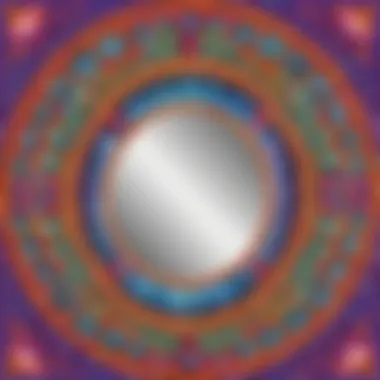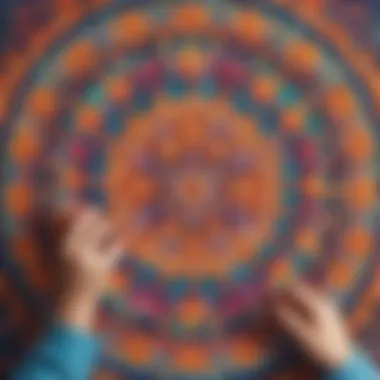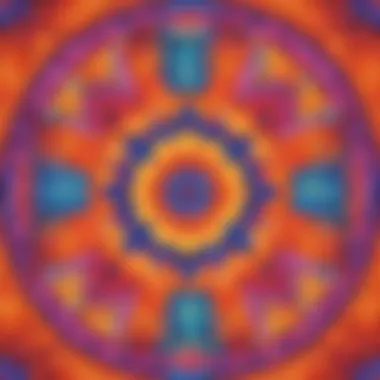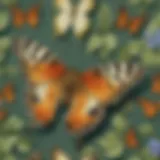Crafting a Kaleidoscope: A Creative and Educational Journey for Kids


Science Fun Facts
In the fascinating world of kaleidoscopes, did you know that the word 'kaleidoscope' originates from Greek words meaning 'observer of beautiful forms?' This optical wonder displays intricate patterns created by simple colors and mirrors, offering a unique blend of art and science for curious minds to explore.
Have you ever wondered how kaleidoscopes work? The magic lies in the mirrors contained within the tube. The reflection and refraction of light within these mirrors create multiple symmetrical images, resulting in the ever-changing and mesmerizing patterns we see. It's like holding a miniature art show in the palm of your hand!
Discover the Wonders of Science
Delve deeper into the fascinating realm of light, color, and symmetry with educational videos and animations that decode the science behind kaleidoscopes. Explore concepts like reflection, symmetry, and geometry in a fun and interactive manner that sparks curiosity and creativity in young minds.
Have you ever thought about how kaleidoscopes are used beyond just as toys? These optical marvels have practical applications in science and art, inspiring innovations in the realms of photography, design, and even psychology. They symbolize the beauty of symmetry and the endless possibilities created by simply reflecting and rotating shapes.
Science Experiment Showcase
Embark on an exciting journey of creativity and knowledge as we step into the DIY world of kaleidoscopes. With a few common materials like cardboard, beads, and mirrors, children can create their own kaleidoscopes at home. Follow the step-by-step instructions carefully, ensuring to prioritize safety by handling mirrors with care and guidance from an adult.
As you assemble the kaleidoscope, observe how light bounces off the mirrors and creates vibrant patterns through the colorful beads. This hands-on experiment not only hones fine motor skills but also teaches youngsters about the principles of light reflection, symmetry, and color blending. Encourage young scientists to make observations, ask questions, and unleash their creativity through this captivating activity.
Introduction to Kaleidoscopes
Kaleidoscopes have long fascinated both young and old with their mesmerizing displays of colors and patterns. In this article, we delve into the captivating world of kaleidoscopes, exploring how these optical instruments work and the joy they bring to those who peer through them. Discover the intricate beauty of kaleidoscopes and how they can inspire creativity and learning in children. Through this DIY project, children will grasp the basics of light reflection and geometric symmetry, sparking their curiosity and imagination.
Understanding the Science Behind Kaleidoscopes
The essence of kaleidoscopes lies in the mesmerizing effects of reflection, where mirrors reflect light creating intricate patterns. This phenomena, known as 'The Role of Reflection in Creating Patterns,' forms the foundation of kaleidoscope designs. By understanding how light bounces off mirrors at different angles, children can appreciate the symmetrical and colorful images produced within the kaleidoscope. This key aspect enhances the overall learning experience, allowing children to explore the magic of optics in a hands-on manner.


Historical Significance of Kaleidoscopes
The intriguing history of kaleidoscopes traces back to their invention and evolution over the centuries. 'Invention and Evolution' shed light on the creators behind these optical marvels and how their designs have transformed over time. From the initial concept to modern adaptations, the kaleidoscope's journey showcases the fusion of art and science. By delving into this historical context, children can appreciate the cultural and scientific impact of kaleidoscopes, fostering a deeper connection to this beloved optical toy.
Benefits of Making Your Own Kaleidoscope
Engaging in DIY kaleidoscope crafting offers a myriad of advantages for children, starting with 'Creativity Enhancement.' By customizing their kaleidoscope with unique decorations and colors, children exercise their creative muscles, fostering artistic expression and innovation. This process not only nurtures a sense of individuality but also promotes problem-solving skills as they design their kaleidoscope. Additionally, the integration of 'STEM Learning' into kaleidoscope creation provides a seamless blend of science, technology, engineering, and mathematics. Through hands-on involvement in assembling the mirror system and understanding light reflection, children gain practical insights into these fundamental STEM concepts, enriching their educational journey with a fun and interactive approach.
Materials Needed for DIY Kaleidoscope
In the fascinating world of DIY kaleidoscopes, the materials required play a crucial role in bringing this optical marvel to life. The choice of materials not only determines the durability of the kaleidoscope but also influences the visual impact of the patterns created. When considering the materials needed for a DIY kaleidoscope, several key elements stand out. First and foremost, a sturdy cardboard tube forms the body of the kaleidoscope, providing structural support for the mirrors and colorful elements inside. Additionally, high-quality rectangular mirrors are essential for reflecting and multiplying the images, enhancing the kaleidoscopic effect. The selection of colorful beads, sequins, or trinkets adds a vibrant touch to the designs, allowing for a personalized and eye-catching appearance. Lastly, transparent adhesive tape or glue is necessary for securing the mirrors and creating airtight compartments within the kaleidoscope. By utilizing these materials thoughtfully, young creators can craft their kaleidoscopes with ease and creativity, fostering a deeper appreciation for optics and geometry.
Gathering Supplies
Before embarking on the kaleidoscope-making journey, gathering the necessary supplies is a critical first step. Begin by acquiring a cardboard tube of appropriate length, ensuring it is strong enough to withstand the construction process and regular use. Next, select rectangular mirrors that fit snugly inside the tube, providing ample reflection space for intricate patterns. When choosing colorful elements such as beads or sequins, opt for a variety of shapes, sizes, and hues to introduce diversity and visual interest to the designs. Consider utilizing transparent adhesive tape for securing the mirrors in place, allowing for easy adjustments and ensuring a seamless assembly process. By carefully gathering these supplies in advance, young enthusiasts can dive into the creative world of kaleidoscope-making with enthusiasm and preparedness.
Step-by-Step Guide to Building a Kaleidoscope
In this enlightening section, we delve deep into the crux of constructing a kaleidoscope, a fundamental process that forms the backbone of this hands-on activity. The step-by-step guide provides meticulous instructions, ensuring a seamless and rewarding crafting experience for the young minds engaged in this project. From sourcing materials to assembling intricate components, the guide empowers children to delve into the realms of creativity and structural understanding.
Preparing the Kaleidoscope Body
Cutting Cardboard Tubes
The Cutting Cardboard Tubes segment unveils a pivotal aspect in kaleidoscope construction, offering insight into selecting and precisely cutting tubes to form the main body. These tubes serve as the foundation for the kaleidoscope, providing structure and stability. Their cylindrical shape and lightweight nature make them an ideal choice for housing the intricate mirror system within. By carefully measuring and cutting these tubes to the appropriate length, children hone their spatial awareness and manual dexterity, setting the stage for a successful kaleidoscope creation.
Decorating the Exterior


As the creative flair of the kaleidoscope, Decorating the Exterior opens avenues for personalization and artistic expression. By adorning the outer surface of the cardboard tubes with vibrant colors, patterns, or designs, children infuse their unique touch into the visual appeal of the kaleidoscope. This customization not only adds aesthetic value but also fosters a sense of ownership and pride in the crafted toy. Through a hands-on approach to decorating, children engage in a sensory-rich experience that combines creativity and fine motor skills development.
Assembling the Mirror System
Inserting Mirrors
The Inserting Mirrors segment explores the critical role of mirrors in creating mesmerizing reflections within the kaleidoscope. Placing mirrors at precise angles within the tube system is crucial to achieving symmetrical and kaleidoscopic effects. Mirrors not only reflect light but also multiply and manipulate images, captivating the viewer with intricate patterns and colors. By skillfully inserting mirrors of suitable size and quality, children grasp the essence of reflection and geometric symmetry, enhancing their understanding of optics and visual perception.
Aligning for Reflection
Aligning for Reflection delves into the meticulous process of ensuring mirror alignment within the kaleidoscope system. Proper alignment is essential for maximizing the reflective properties of the mirrors, allowing for clear and vivid patterns to emerge. By fine-tuning the position of mirrors to optimize reflections, children practice attention to detail and precision, skills that are integral to both scientific exploration and creative expression. Through aligning mirrors effectively, young builders unlock the magic of symmetry and create captivating visual displays.
Adding Colorful Elements
Selection of Beads and Sequins
An essential stage in kaleidoscope design, the Selection of Beads and Sequins offers a broad spectrum of creative possibilities. Choosing beads and sequins in various shapes, sizes, and colors elevates the visual richness of the kaleidoscope's chamber. These elements not only contribute to the aesthetic appeal but also influence the dynamic patterns and color combinations produced when the kaleidoscope is rotated. By handpicking beads and sequins to suit their artistic vision, children engage in color theory exploration and sensory stimulation, fostering a deeper appreciation for visual aesthetics.
Filling the Kaleidoscope
Filling the Kaleidoscope marks the final step in assembling the optical toy, culminating in a kaleidoscope ready to unveil its enchanting patterns. By carefully arranging selected beads and sequins within the tube alongside reflective elements, children create a kaleidoscopic environment that reacts dynamically to motion. The act of filling the kaleidoscope chamber involves spatial reasoning and creativity, encouraging children to experiment with different compositions and observe the resulting visual symphony. Through this tactile experience, young creators witness art and science converge in a mesmerizing display of color and light.
Exploring Patterns and Colors
When engaging in the delightful activity of making your very own kaleidoscope, the phase of exploring patterns and colors becomes a pivotal part of the process. It is through this exploration that children get to witness the mesmerizing effects of light and reflection coming together to create intricate geometric designs. By rotating the kaleidoscope, young minds are exposed to a world of symmetry and vibrant hues that stimulate their creativity and visual senses. This hands-on experience not only entertains but also educates, as it introduces kids to concepts of optics and color theory in a fun and engaging manner. By observing the ever-changing patterns and colors within the kaleidoscope, children develop an appreciation for the beauty of light manipulation and the endless possibilities it offers in crafting unique visual compositions.


Rotating the Kaleidoscope
Observing Symmetry and Reflection
Rotating the kaleidoscope unveils a magical realm where symmetry and reflection reign supreme. The act of turning the cylindrical device allows children to witness the symmetrical patterns created by the mirrors reflecting colorful beads and sequins. Symmetry, a fundamental concept in geometry, is beautifully showcased through the kaleidoscope's intricate designs, captivating young learners and fostering an understanding of balance and visual harmony. Reflections, on the other hand, introduce kids to the science of optics, as they observe how light bounces off surfaces to produce mirror images within the kaleidoscope. This immersive experience not only entertains but also educates, as children grasp the relationship between angles of incidence and reflected light within this colorful optical instrument.
Creating Customizable Designs
As kids delve into the realm of kaleidoscope creation, they are encouraged to experiment with mixing and matching colors to craft customizable designs. The process of combining different hues and arranging beads and sequins inside the kaleidoscope offers a hands-on lesson in color theory and personal expression. By exploring various color combinations, children develop an eye for aesthetics and composition, honing their artistic skills while enjoying the sensory delight of witnessing colors blend and merge in captivating patterns. This creative freedom allows young minds to express themselves artistically, reinforcing the understanding that art and science intertwine to produce visually striking results. The option to personalize their kaleidoscope provides children with a sense of ownership and pride in their creations, enhancing their confidence and igniting a passion for further artistic explorations.
Learning and Fun Combined
To comprehend the essence of learning and enjoyment entwined harmoniously in the context of this article, we delve into a realm where education seamlessly integrates with amusement. The fusion of learning and fun within the realm of DIY kaleidoscopes transcends mere entertainment, offering a gateway to interdisciplinary exploration. Enabling children to actively participate in the construction of their kaleidoscopic wonders not only facilitates a hands-on learning experience but also ignites their curiosity to understand the underlying principles of light reflection and geometric symmetry. The process of crafting a kaleidoscope becomes an avenue for youngsters to grasp challenging concepts in an engaging and interactive manner, fostering a spirit of creativity and experimentation. Through this symbiotic relationship between learning and fun, children embark on a journey where playfulness merges with cognitive growth, leading to a profound appreciation for the wonders of science and art.
Educational Value of Kaleidoscopes
Exploring Light and Optics
Embarking on a voyage to unravel the mysteries of light and optics through the medium of kaleidoscopes holds profound educational value. The facet of Exploring Light and Optics within this article serves as a foundational pillar for young learners to grasp fundamental principles of physics in a visual and captivating manner. By peering through the intricate patterns reflected within the kaleidoscope, children are introduced to the magic of light refraction and reflection, enhancing their awareness of how color and symmetry intersect in the natural world. The interplay of light within the kaleidoscopic chamber unveils a mesmerizing spectacle, allowing budding scientists to observe firsthand the transformative effects of mirrors on the propagation of light. This hands-on encounter with optical phenomena cultivates a deeper understanding of the scientific method while kindling a sense of wonder and curiosity regarding the mysteries of the universe. Exploring Light and Optics within the kaleidoscope not only enriches the learning experience but also instills a sense of awe and appreciation for the interconnectedness of art, science, and the boundless wonders of the cosmos.
Conclusion
In this hands-on journey of creating a DIY kaleidoscope, the Conclusion serves as a crucial element encapsulating the essence of the entire activity. It signifies the culmination of artistic expression, educational exploration, and sensory delight that children experience throughout the kaleidoscope-making process. By concluding this DIY project, kids not only gain a tangible optical toy but also acquire invaluable knowledge about light reflection, geometric patterns, and color combinations. The Conclusion of this article beautifully ties together the practical and educational aspects, leaving young minds with a sense of accomplishment and wonder.
Inspire Curiosity and Creativity
Encouraging Hands-On Learning:
The core component of encouraging hands-on learning in the context of this DIY kaleidoscope project lies in its ability to truly engage children in a tactile and interactive manner. By encouraging hands-on exploration, kids get the chance to actively participate in the process of creation, learning through experimentation and observation. This hands-on approach not only enhances their understanding of concepts like reflection and symmetry but also fosters a sense of independence and creativity. The hands-on aspect of learning promotes problem-solving skills, critical thinking, and spatial reasoning, all of which are integral to a child's holistic development.
This emphasis on hands-on learning is a beneficial choice for this article as it aligns perfectly with the objective of combining education with recreation. By actively involving children in the construction of their kaleidoscopes, we instill in them a sense of ownership and agency over their learning experiences. The hands-on nature of the activity ensures that kids are not just passive spectators but rather active participants, driving their curiosity and fostering a sense of accomplishment. The interactive nature of hands-on learning also allows children to experiment with different materials, shapes, and colors, honing their motor skills and spatial awareness.
The unique feature of hands-on learning lies in its kinesthetic approach to education, catering to varied learning styles and preferences. For some children, the hands-on aspect provides a sense of sensory satisfaction and physical engagement that traditional study methods may lack. It leverages the natural inclination of kids to touch, explore, and create, channeling this enthusiasm into a meaningful learning experience. By embracing hands-on learning in this article, we tap into the innate curiosity and creativity of children, nurturing their passion for experimentation and discovery.







